Each year, at the National Conference or Summer Institute, the Lifetime Achievement Award is given to honor extraordinary service to The American Harp Society, Inc. and the harp. Please submit nominations online by February 15th.
Select a name to read the stories of these outstanding Lifetime Achievement Award winners:
2024 David Day
2024 Cheryl Dungan Cunningham
2023 William Lovelace
2022 Karen Lindquist
2020 Catherine Anderson
2018 Mario Falcao
2017 Barbara Weiger Lepke-Sims
2016 Linda Wood Rollo
2015 JoAnn Turovsky
2015 ShruDeLi Ownbey
2014 David Kolacny
2013 Faith Carman
2012 Lucy Scandrett
2012 Jan Bishop
2011 Molly Hahn
2010 Lynne Wainwright Palmer
2010 Sally Maxwell
2009 Patricia Wooster
2008 Samuel Milligan
2008 Ruth Wickersham Papalia
2007 Anne & Burton Adams
2006 Anne Mason Stockton
2004 Dorothy Remsen
2002 Catherine Gotthoffer
Dr. David Day
2025
|
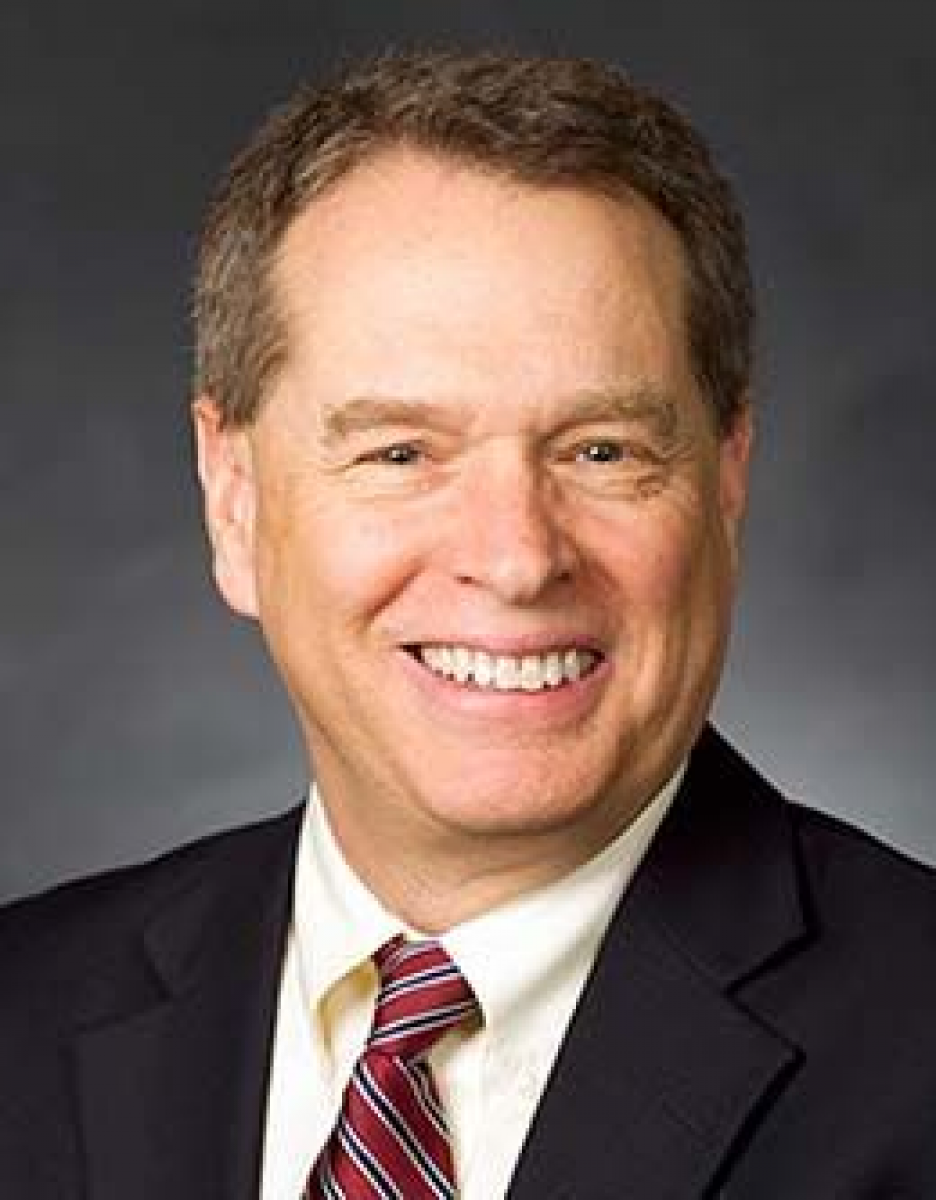 |
The recipient of the 2025 AHS Lifetime Achievement Award is Dr. David A. Day, the curator of the International Harp Archives and only the second non-harpist recipient of this recognition.
David has worked as Music Librarian and Curator of Music Special Collections at Brigham Young University in Provo, Utah since January 1986. He also teaches the graduate research methodology course in the BYU School of Music. The Archives began as a significant collection of harp music and archival materials donated by Samuel and Rosalie Pratt. The collection grew and the International Harp Archives were formally established at Brigham Young University in 1994. Since then, David has become synonymous with the Archives and as past AHS President, Lucy Scandrett shared, “he is the heart and soul of our exceptional Archives. His extraordinary research skills, thorough documentation, willingness to adapt to AHS requests, and creative expertise have given the harp world an invaluable resource for the harp.”
The Archives serve as a support center for research dealing with aspects of the harp, its music, and harpists. It consists of items ranging from scores, manuscripts and recordings, to photographs, correspondence, programs and other documents including the Archives of the American Harp Society. The International Harp Archives are now perhaps the largest collection of harp materials in the world.
University of North Texas Professor, Jaymee Haefner shared that even before she was a professional David was willing to guide and help her in her research in the Renie portion of the archive which eventually led to her meeting the Renie family. She said he is truly the bridge to “living research” in our discipline.
David earned the PhD in musicology from New York University in 2008. His dissertation deals with the annotated violon répétiteur, or markings in the violin conductor’s part used in the production of early 19th-century French ballets. The dissertation addresses ways in which ballet music was written to underscore specific dramatic action as evidenced in the correlation between the staging instructions found in the violin conductor’s part and specific dramatic devices of the accompanying music.
Prior to completing the PhD, Day earned an MS in Library and Information Science from the University of North Carolina at Chapel Hill (1985) and the BA in music theory and MA in musicology from Brigham Young University (1978 and 1981).
He completed a six-year term as Chair of the Bibliography Commission of the International Association of Music Libraries in July 2011. He also served as Founding Chair of the IAML Subject Commission on Archives (1987-1993) and Chair of the Working Group on the International Registration of Music Archives (2000-2005). Among other positions held in the Music Library Association, Day served as the Chair of the Archives Roundtable from 1993 to 1995. He published two indexes for the RIPM Series (The Message Bird and New York Musical World).
David maintains a website and database devoted to the bibliography of music and dance reference sources that lists more than 13,000 items approximately 2,100 of which are fully critiqued (see URL: musref.byu.edu ). He also created an online index of opera and ballet primary sources that are available in digital format for free online. This index, referred to as OBPS, now indexes more than 50,000 items. Day’s research interests remain focused in dramatic music of early 19th-century France and Belgium. He is nearing completion of a descriptive catalogue of the opera and ballet performance materials from the Théâtre de la Monnaie currently housed at the Archives de la Ville de Bruxelles. He especially enjoys interacting with students and guiding them toward research projects based in critical analysis of primary sources.
Along with his stellar professionalism, anyone who has met David knows him to be an exceptionally humble, patient, and kind person.
Cheryl Dungan Cunningham
2024
|
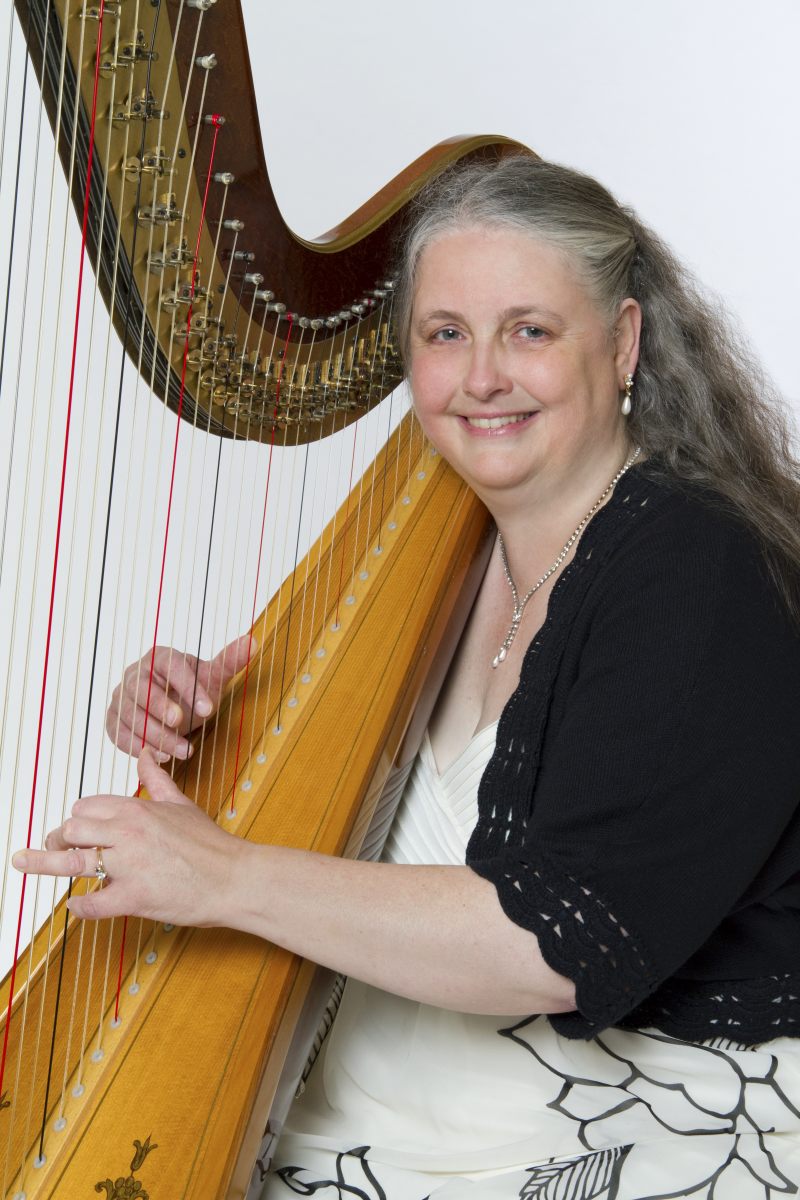 |
Cheryl Dungan Cunningham is at home as an orchestral, chamber or solo performer. Performing full time since 1982, Cheryl began studying the harp at the age of eight. A student of noted teachers Susann McDonald and Peter E. Eagle, she earned her Master of Music, Bachelor of Music Education and Bachelor of Music degrees with high distinction from Indiana University, Bloomington, Indiana.
Cheryl’s service to AHS includes:
- Long time Treasurer for the Philadelphia Chapter of the AHS
- Co-Chair of the AHS National Conference in Philadelphia (2004)
- Cheryl initiated the first website for the AHS and served as the original website liaison.
- Chairman of the Board of Directors (2014-2016)
- First Vice President (2006-2010)
- Chair of the AHS Governance Committee
- Chair of the 2020/2024 National Conference, twice postponed and re-planned due to COVID-19. It was at the 2024 event in Orlando that Cheryl received this honor.
As a pedagogue and author, Cheryl maintains a busy private teaching studio and teaches at Cairn University. She has contributed as a writer to the American String Teacher’s Association publication, A Harp in the School: A Guide for School Ensemble Directors, and her articles published in Harp Column Magazine, The American String Teacher, and the AHS Teachers Forum.
As a soloist, Cheryl has appeared with the Academy Chamber Society, Ambler Symphony and the Philadelphia Doctors' Symphony, and she was the winner of the concerto competition at Indiana University in 1981. An active recitalist, Cheryl has performed in a variety of settings, including retirement communities, schools, and for several appearances in the "Recitals at Trinity Cathedral" series.
With flutist Nicole Lambert and violist James Day, Cheryl founded the SOUTHAMPTON TRIO in 1992. The Trio is the resident ensemble of the Southampton Chamber Music Society, which presents an annual series of chamber recitals. Her other chamber group, THE FINE COMPANIONS, with Amy Shimmin, flute and recorder, and Cheryl on both lever and pedal harps, have been performing together since 1990. Their first CD, Echoes of the Dance, a collection of dance music from the Renaissance and the British Isles, was released in 1998.
Principal harpist for the Delaware Valley Philharmonic, Greater Trenton Symphony Orchestra and Boheme Opera, NJ, Cheryl Dungan Cunningham maintains her teaching studio just outside of Philadelphia, PA. Besides her teaching, recording and symphonic engagements, Cheryl has performed for countless special events and has entertained patrons of numerous restaurants, including long running restaurant engagements performing popular music at the William Penn Inn Commonwealth Club, Country Veranda, and La Petite Roche in the Little Rock Excelsior Hotel.
William Lovelace
2023
|
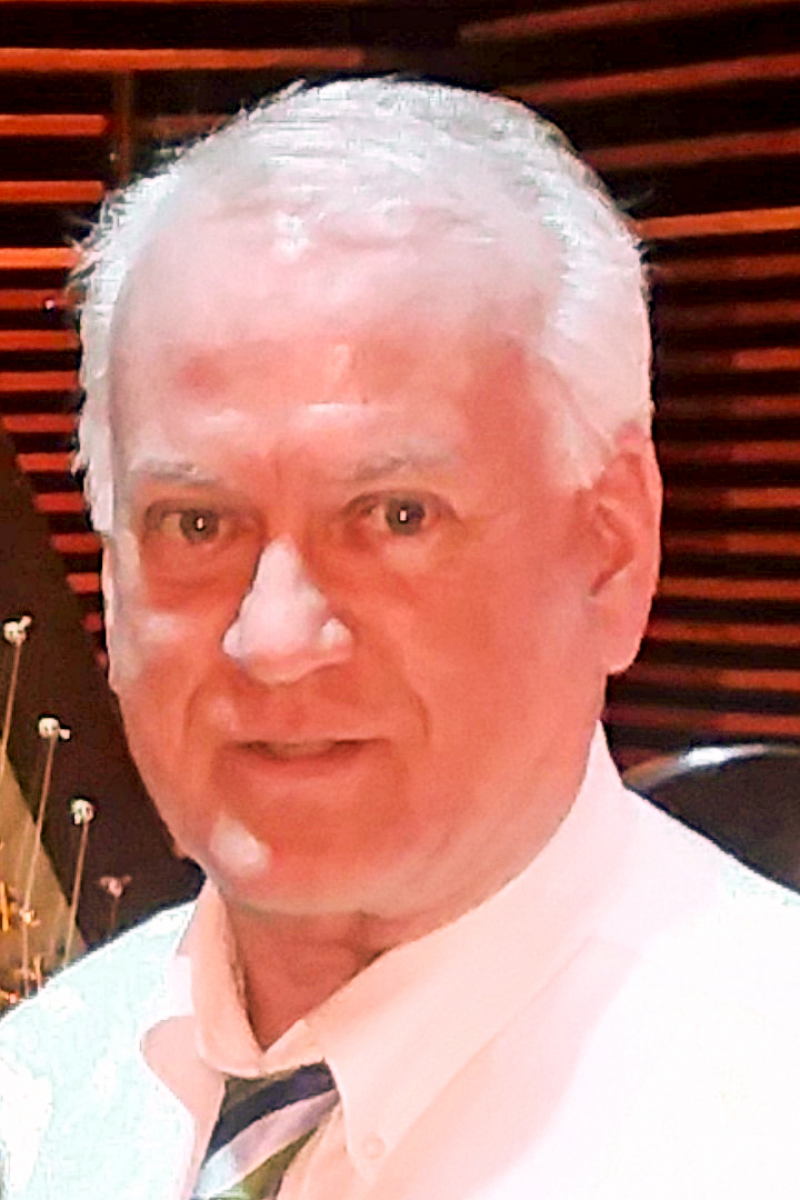 |
William Lovelace studied harp with Dr. Kathy Bundock Moore, during his undergraduate studies at the University of Northern Colorado. Years later, he served on a committee, chaired by Dr. Moore, which compiled the first "Graded Repertoire List for Harp" published by the American String Teachers Association.
In 1984, William met the great harp pedagogue, Lucien Thomson (1913-2000), and began collaborating on educational material and compositions for beginning harp students. Mr. Thomson was the first chair of the Music Education Committee of the American Harp Society, founded in the early 1960's. William became a member of the Music Education Committee in 1990, and served as chair from 2000-2016 (after the death of Mr. Thomson in 2000.) William also studied with Anne Adams, in Oakland, California, while completing a Master's Degree in Music, at Holy Names College (1988-1989).
Adams and Thomson were both in Marcel Grandjany's first class at the Julliard School of Music. (Grandjany immigrated to the United States during WWII, and taught at the Julliard until his death in 1975.) Dr. Moore's mother was also a student of Grandjany. Grandjany studied at the Paris Conservatoire around the turn of the last century; first with Henriette Renie, and later with Alphonse Hasselmans.
William Lovelace served on the National Board of Directors of the American Harp Society for 12 years, and was National President of the American Harp Society from 2002-2006. He now serves as a permanent member of the Presidential Advisory Committee of the AHS. William served on the Executive Committee of the National Board for most of his 12 years on the board, and was also National 2nd Vice President for two years. He served from 1990-2016 on the Music Education Committee of the AHS, and chaired that committee from 2000-2016. He also served as chairman of the AHS Educational Advisory Committee for 16 years during which time he wrote 26 issues of "Uncle Knuckle's kNews," an informative student newsletter which accompanied each American Harp Journal publication for 13 years. (All the delightful illustrations for the newsletter were provided by the ever-whimsical, David Kolacny. Back issues of the newsletter are available through the American Harp Society online member portal at no charge to members.)
William has served as secretary and/or treasurer of the local East Tennessee Chapter of the AHS continually since moving to Knoxville in 1989.
Karen Lindquist
2022
|
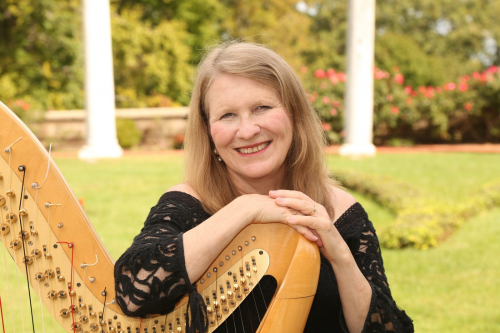 |
|
The 2022 Lifetime Achievement Award winner is Karen Lindquist Speyer, who first became involved in the AHS in 1967. In 1969, she won the Advanced Division of the National Competition.
She has served multiple terms on the AHS board, and served as an officer in the capacity of Treasurer, First Vice President, and Chairman of the Board. Karen ran the Concert Artist Program for many decades and served as a judge for many years. She has also worked on the National Conference in New York City in 2012, and has served on the Grants Committee since 2010, working as co-chair since 2015.
This slideshow accompanied the presentation of Karen's award at the 2022 National Conference in Sioux Falls, SD, on June 22, 2022.
|
Catherine Anderson
2020
|
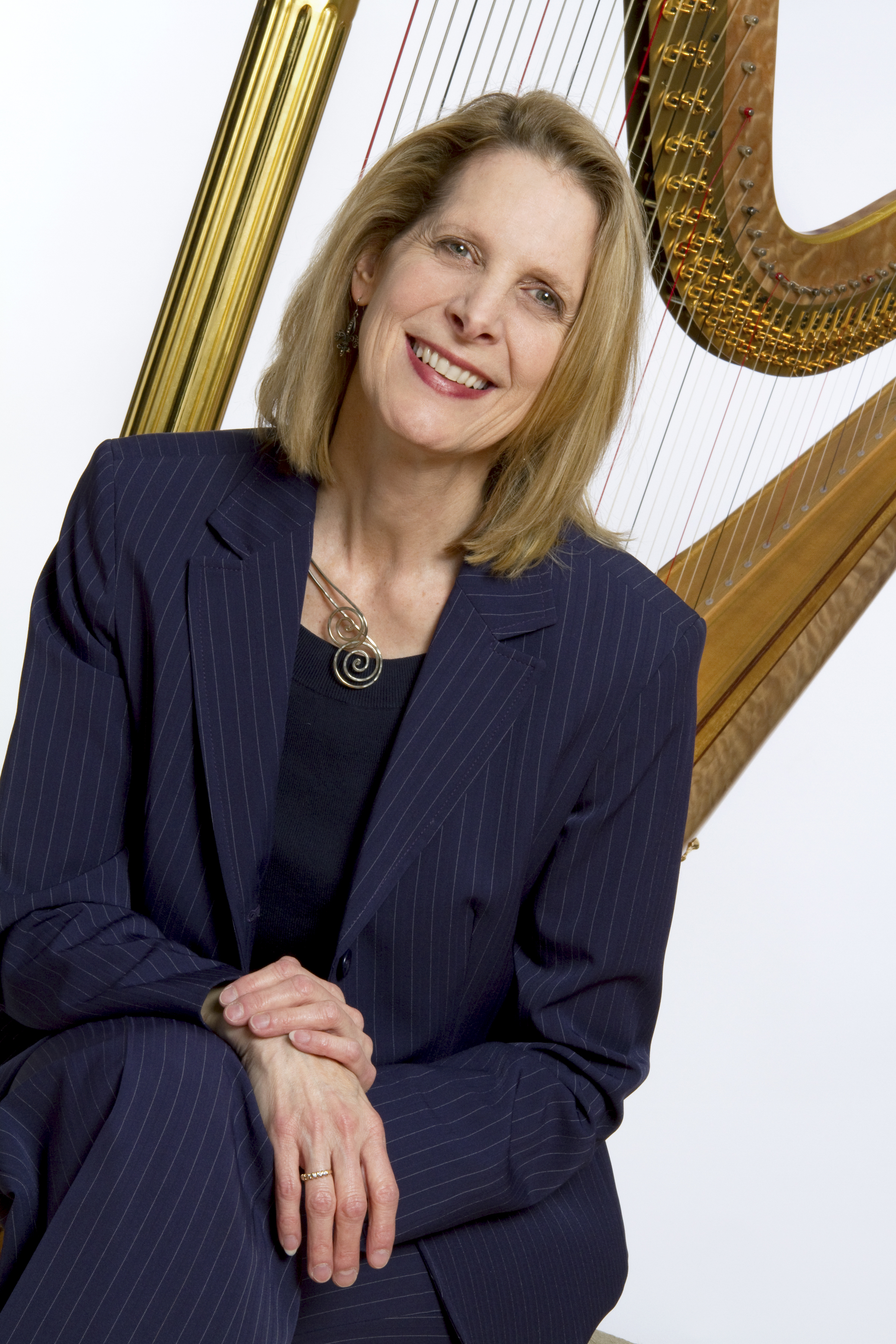
|
|
The 2020 Lifetime Achievement Award of the American Harp Society, Inc. was presented to Catherine Anderson. Ms. Anderson has long served the AHS as a conscientious steward in her various roles of fiduciary responsibility. She currently serves the Society as Chair of the Financial Investment AdvisoryCommittee and as Financial Group Coordinator, having previously served as Treasurer from 2001-2006. Additional board positions held include Southern Regional Director and Director-at-Large. She has held various executive officer positions with the New Orleans Harp Society and was Chair of the 41stAHSNational Conference in 2014. Ms. Anderson holds multiple degrees in Accounting and Music. She has worked in a full-time capacity for the Muscular Dystrophy Association for the past three (3) years in addition to maintaining an active private harp studio and freelance harp engagements.
|
Mario Falcao
2018
|
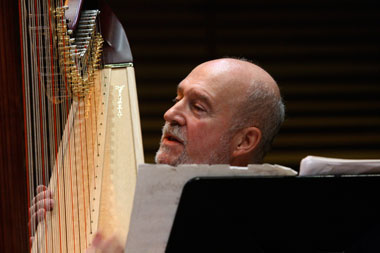
|
|
Mario Falcao is Professor Emeritus for the State University of New York at Fredonia, NY, and a Visiting Professor at the Escola Superior de Música de Lisboa, Portugal. A native of Lisbon, Portugal, Professor Falcao attended the Lisbon Conservatory where he was awarded a diploma in Harp Performance. He attended the Eastman School of Music in Rochester, New York, on a Fulbright scholarship, where he completed both the Master of Music degree and the Performer's Certificate, studying harp with Eileen Malone. Additional studies were with Phia Berghout in Holland, the Netherlands.
At the 5th International Harp Contest in Israel in 1973, Mr. Falcao received a special prize for the outstanding performance of a contemporary work. This early recognition stayed with him throughout his career, as he has been a dedicated and vocal champion for contemporary composers. Through his extensive International career as a chamber musician, orchestral soloist, and recitalist dedicated to the commissioning and performance of works for the harp from composers in Europe, the United States, and South America, Mr. Falcao has generated countless opportunities for composers and harpists alike to express themselves through the creation and realization of new music. He was a member of the Creative Associates of SUNY at Buffalo where he worked closely with 20th Century luminaries John Cage, Lukas Foss, and Morton Feldman among others. He has collaborated in festivals of Contemporary music, through master classes and in harp festivals in Africa, Asia, Australia, Europe, and North and South America.
Mr. Falcao's initial involvement with The American Harp Society came about in 1969, when he attended the National Conference held at the Eastman School of Music. He found the experience of hearing and meeting great harpists and unique personalities memorable; a remarkable example of the power of music to initiate friendships and create community. He subsequently attended and participated in numerous AHS national conferences, has served numerous terms as a member of the Board of Directors, and as Chairman of the Board from 1975-1979; hosted the 1980 national conference at SUNY Fredonia, NY and in 2017 ended a six-year term of service as New York Regional Director. Mr. Falcao is a founding member of the World Harp Congress (1981) and a member of its Board of Directors, service which extends his lifelong commitment to fostering the creation and performance of contemporary music for the harp and supporting the work of world-wide harp organizations in creating a global community of friendships through the harp.
|
Barbara Weiger Lepke-Sims
2017
|
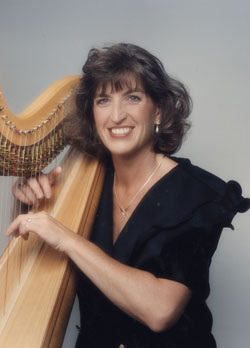
|
|
Barbara Weiger Lepke-Sims fell in love with the harp when she was five years old and her mother took her to a harp program presented by Alice Chalifoux and her students. Barbara was twelve years old and living in New Jersey when she started taking harp lessons. The American Harp Society, Inc. figures into her earliest memories at the harp, from participating in the Music Education Evaluation program at Sam and Rosalie Pratt's home, where Kathleen Bride and Jane Weidensaul were the adjudicators.
Barbara holds the Bachelor of Music Education degree from the University of Colorado, Boulder, studying with Helen Hope, who prepared her to be self-supporting throughout all phases of life, and the Master of Music degree from the Juilliard School, studying with Susann McDonald. New York provided Barbara with some amazing performing opportuni-ties, including playing The Fantasticks in the Sullivan Street Theatre, being a soloist for Lincoln Center Student Programs and performing in Carnegie Hall with the Young Americans in Concert. Barbara returned to Colorado following graduate school, where she has pursued a career performing and teaching. In 2009, Barbara expanded her areas of interest and expertise and became a Certified Music Practitioner, playing for patients in several hospitals. She recently became the Healing Arts Program Coordinator for part of the largest healthcare system in Colorado.
Barbara has been volunteering her time for the American Harp Society, Inc. since 1986. She has served as President of the Mile High (Denver) chapter; as Midwestern Regional Director, Director-At-Large, and Chairman of the Board of Directors. Colorado was the site of the 1988 National Conference in Denver and the inaugural Summer Institute in Greeley in 1995. Barbara was Co-Chair for both events. As Chairman of the Board, Barbara served as Chair of the Long Range Plan/Strategic Planning Committee, helping to steer the course of the AHS over the past 30 years. Barbara organized the numerous AHS committees into the organizational structure used for many years, spearheaded the development and implementation of the AHS website and served as the website liaison for twelve years. She served as Media Group Coordinator from 1996-2010 and oversaw the production of the Sharing the Passion video, which is on the AHS homepage. She was a member of The American Harp Journal Editorial Board from 1995-2016.
Barbara became interested in encouraging composers to write for the harp through her membership on the Board of Directors of the AHS Foundation. In 2000, Barbara and her husband Mike established the Weiger Lepke-Sims Family Sacred Music Award. The intent of the award is to encourage composers to write works for harp and ensemble to increase the harp repertoire in sacred settings. The award is given in memory of Barbara’s parents and grandmother, and in appreciation of her family. Barbara is honored to be receiving the 2017 Lifetime Achievement Award, and looks forward to continuing her friendships and contributions to the AHS.
|
Linda Wood Rollo
2016
|
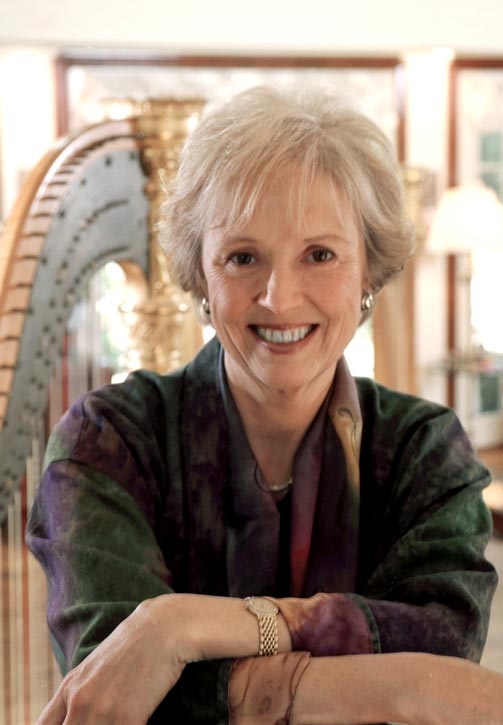
|
|
Linda Wood Rollo is a teacher, composer and arranger of harp music. She currently lives in Saratoga, California, where she teaches privately and is President of the Silicon Valley Chapter of the AHS.
She has been a member of the AHS since 1965, and was fortunate to be part of the Los Angeles AHS Chapter during the reign of Dorothy Remsen, Ann Stockton, Catherine Gotthoffer, Marjorie Call and many other great harpists of that region who inspired her tremendously. Linda first served on the Board of Directors of the American Harp Society as a Director-at-Large, and then as Chairman of the Board from 2002-2006. She has been a contributing writer for the American Harp Journal and a both a performer and speaker at AHS conferences throughout the years.
Along with her support of the AHS, she is currently a Vice-President of the World Harp Congress and Vice-President of the USA International Harp Competition.
She was the Founding Editor of the World Harp Congress Review, a publication started in 1984 in nine languages to bring the international harp community together in communication, in the days before email, fax or the personal computer. The WHC Review is now respected as a primary source of archival material relating to the harp. In 2002, upon her retirement, The World Harp Congress bestowed its highest honor on her, the “Award of Recognition for Service to the International Harp Community” at the WHC Congress in Geneva, Switzerland.
Together with Susann McDonald, she has written and published over 25 volumes of music and teaching materials for the harp under the MusicWorks-Harp Editions Label.
Linda Wood Rollo holds a Bachelor of Music degree from the University of Redlands (later to receive their Distinguished Alumni Award), and a Master of Music degree from the University of Southern California (USC) with the Adolf Koldofsky Performance Grant. She has taught on the harp faculties of Indiana University, The Louisville Ursuline School of Music and Drama, San Francisco State University, Dominican College and San Domenico School for Girls. She toured under the auspices of Columbia Artists both with orchestra and as a soloist for many years and served as “Artist in Residence” at the University of Surrey, England. She made five tours of Alaska sponsored by the National Endowment for the Arts.
|
JoAnn Turovsky
2015
|
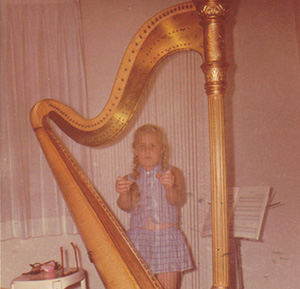
|
|
I competed in 1972 and 1975 winning Intermediate II and Young Professional. I judged in 1978 and then took over as Chairman in 1981. I have two main goals. First, to always maintain the competitors point of view and second to run as fair an event as possible. In addition, I always strive to improve. There have been many evolutions over the years: Five divisions instead of three or four. Competition every two years instead of three and most recently video uploads instead of audio tapes. I have enjoyed seeing young harpists grow and learn over the years and to watch the level of competition rise astronomically!
JoAnn Turovsky
JoAnn Turovsky is principal harpist with the Los Angeles Opera Orchestra, the Los Angeles Chamber Orchestra, and the Los Angeles Master Chorale and Sinfonia Orchestra. She has been the professor of harp at the USC Thornton School of Music for the past thirty-five years and is on the faculty of the Colburn Conservatory of Music and the Colburn School of Performing Arts.
Turovsky’s numerous awards and citations include first prize in the American Harp Society National Competition, Young Professional Division, the first prize in the Coleman Competition for Chamber Music, prizewinner at the Fifth International Harp Competition in Jerusalem, Israel, and an award from the Young Musicians Foundation. She is chairman of the American Harp Society National Competition.
Turovsky is also a “first call” musician for a plethora of film and television assignments. The composer John Williams wrote a solo piece for Turovsky that was featured on the soundtrack of the film Angela’s Ashes, while her performances also grace such films as Frozen, Big Hero 6, Tinkerbell, Avatar, Raiders of the Lost Ark, The Karate Kid, Toy Story (plus its sequels), The Kite Runner, and Thirteen Conversations About One Thing, among the more than 400 movie soundtracks in which she has participated.
Her spare time is happily devoted to being out smarted by her Australian Shepherd, Reggie and two equally busy cats Max and Nike.
|
ShruDeLi Ownbey
2015
|
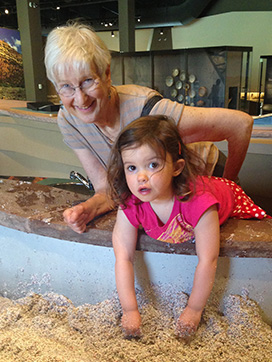
|
|
From the moment I stepped off the bus in 1986 at the AHS Conference held at UCLA, I became a fan of the American Harp Society, Inc. Dorothy Remson held out her hand, called me by my first name, and welcomed me to Los Angeles. I never forgot that personal touch. This event made me want to attend every subsequent AHS Conference. The icons in the harp world are all around you listening, learning, and contributing.
I have been part of organizing three AHS Summer Institutes in Utah and it has been a privilege to work with people I value as friends both locally and nationally. 2003 was held at the University of Utah, 2009 at Westminster College, and 2015 at Utah State University. I can tell you it has been an education!
I learned there are many “bosses” during the Summer Institute and AHS National Competition and one can only understand the system by rolling up your sleeves and working hard. We are trained as harpists, not conference organizers but we are called to step into those roles for the greater good of the harp world and we do so willingly.
First, there are the needs of the fabulous American Harp Society’s National Competition. They work hard to make the experience fair to each competitor.
Second, as mandated in the AHS Bylaws, there are long hours of spent in meetings of the Board of Directors and Executive Committee and those people work all year to deal with the issues of the American Harp Society. These people donate their time and try to represent all of us.
Third, in alternating years, there are the needs of either the Foundation Awards or the Lyon & Healy Awards. These two organizations contribute thousands of dollars to the education of young harpists through scholarships and cash awards.
Fourth, there are the classes and concerts presented by harpists at their own expense. No one is compensated for their participation as presenters. The presenters share their discoveries with us because they are passionate about what they have been doing.
Every time you look at the stage or classroom and see all of the harps in front of you, we need to realize they have been loaned, tuned, and regulated by local harpists or Lyon & Healy. We need to thank many people who have sacrificed their instruments during the week. All of the competitions, concerts and presentations are taking place through the donations of harps by Lyon & Healy and the local harpists.
When I receive this award, it is with complete understanding that my committee members Anamae Anderson, David Day and Chilali Hugo have contributed as much to the success of these three AHS Summer Institutes. Thank you.
ShruDeLi Ownbey
ShruDeLi Smith Ownbey received her BA, MA from the University of Utah 1963 – 1971. During that time, she took a hiatus to attend the Curtis Institute of Music 1966 – 1968.
In the summers of 1962 and 1963 she attended the Music Academy of the West and received the award for the “most improved student.” This study was developed from her being glued to the bench of the rehearsal pianist and turning pages. It was a great way to learn about opera from great teachers. The harp part was much easier to play once the entire opera was studied from the singers’ perspective.
One of the most satisfying accomplishments has been to teach students as young as 2 ½ to play the harp. For 31 years ShruDeLi has used the Suzuki Mother-Tongue Method to teach the instrument. During this time, she was adjunct professor eight years at the BYU and 21 years at the University of Utah but the pleasure of beginning young students and being part of their lives for 18 years has surpassed all other teaching experiences.
As a young student she soloed twice with the Utah Symphony on their Salute to Youth Concert series. ShruDeLi played professionally for 30 years with the Utah Symphony and the Honolulu Symphony.
Her husband Ray Ownbey, son Micah Ownbey, daughter-in-law Casey Murphy, and granddaughter Iris are all part of her cheering squad.
|
David Kolacny
2014
|
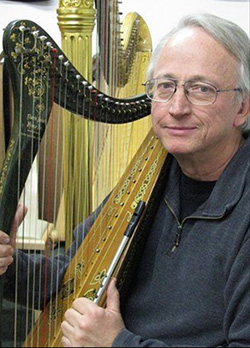
|
|
David Kolacny has been repairing, renting and selling harps for over 30 years. He manages Kolacny Music in Denver Colorado, a family business started by his Grandfather in 1930. With his wife Debbie he publishes harp music as Harps Nouveau.
David has served the American Harp Society, Inc. as Chairman of the Board, National Treasurer and various other Board positions. As a graphic designer David created logos that have been used by the Society for many years. He also wrote the slogan “AHS membership, more than just a magazine”.
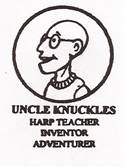 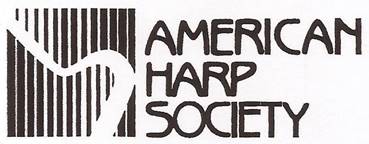
Uncle Knuckles Knews was created by William Lovelace with artwork and cartoons by David Kolacny. Uncle Knuckles was a supplement to The American Harp Journal from 1994—2007. Its aim was to appeal to the youngest members of the American Harp Society, Inc.
David became National Exhibit Chairman for the American Harp Society in 1988 and has managed the exhibits for 18 National AHS Conferences. He has also run exhibits for The World Harp Congress and many Folk Harp conferences.
David is a member of the Lyon & Healy/Salvi Technicians Guild and is currently President of the International Society of Folk Harpers and Craftsmen. David may be best known for his book, Trouble Shooting Your Lever Harp and the “Official Harp Mover” t-shirts.
|
Faith Carman
2013
|
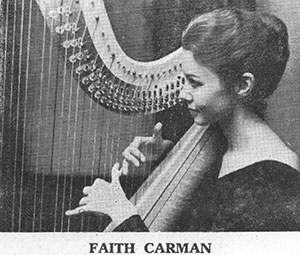 |
|
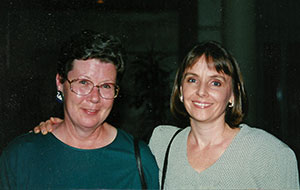 Faith Carman has made numerous contributions to the harp community as a performer, teacher and music publisher, as well as through her service to the American Harp Society. She studied with Carlos Salzedo both in Camden, Maine and at the Curtis Institute of Music, and earned a Bachelor of Music from Catholic University. Faith Carman has made numerous contributions to the harp community as a performer, teacher and music publisher, as well as through her service to the American Harp Society. She studied with Carlos Salzedo both in Camden, Maine and at the Curtis Institute of Music, and earned a Bachelor of Music from Catholic University.
During the course of her career, Faith was principal harpist of many orchestras, including Orquesta Sinfonica de Colombia, National Ballet, Kennedy Center Opera House, Oakland Symphony, San Rafael Symphony, Santa Rosa Symphony and Yakima Symphony. In addition, she performed as second harpist with the National Symphony, Baltimore Symphony, San Francisco Symphony and S F Contemporary Music Players. A prolific freelancer, Faith is particularly proud of her 174 performances of Britten’s Ceremony of Carols.
In addition to her private teaching studio, Faith also taught harp at Howard University, George Washington University, San Francisco Conservatory and San Francisco State University. In 1985, she founded F C Publishing, arranging and publishing works for the harp until 2001.
Faith has participated in three AHS National Conference workshops, and performed a solo work written for her in a chamber concert at the 1967 National Conference. She served the AHS locally as President of the Washington D.C. and the Bay Area Chapters, and nationally for two years as Vice President and ten years as Chairman of the Board. Currently Faith is the Chairman of the Escosa Memorial Fund, a position she has held for more than twenty years.
|
Lucy Scandrett
2012
|
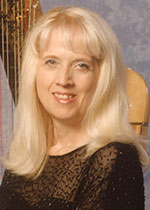 |
|
Lucy's involvement with the American Harp Society began when she wrote a letter to Sylvia Meyer, Chapter Chairman of the AHS at that time, asking about starting a Chapter of the AHS. In 1978 she started the Pittsburgh Chapter of the AHS serving as President and other offices in the chapter and started the Chapter Holiday Concerts. In 1987 she was the AHS National Conference Chair for the Conference at Chatham University. She has served on the Board of the AHS for 18 years beginning in 1989 and was the MidAtlantic Regional Director for 6 years, RD Coordinator for 1 year, 1st Vice-President for 1 year and President for 8 years. She has served on many committees and continues to serve as Group Co-Coordinator (with Jan Bishop) of the National Conferences and Institutes, on the Presidential Advisory Committee, on the Grant Committee and as Chair of the Interview Series.
Lucy's professional career includes Principal Harp of the Pittsburgh Ballet Orchestra (25 years) and Pittsburgh Opera Orchestra (15 years), Civic Light Opera Orchestra (32 years), solo Harpist for the Pittsburgh New Music Ensemble (25 years), Principal Harpist of the Johnston Symphony, Butler Symphony, Westmoreland Symphony and McKeesport Symphony (currently), Gateway to the Arts(currently) and numerous other organizations. She continues to perform with orchestras and choirs in the Greater Pittsburgh area, give recitals and teach at Indiana University of PA, Chatham University, Seton Hill University, Geneva College, the Ellis School, the School of Music of Musik Innovations, the Creative and Performing Arts 6-12 School in Pittsburgh in addition to a private studio. She has performed with major artists of opera and shows for many years, from Joan Sutherland, Luciano Pavarotti and Placido Domengo to Yul Bryner, Bernadette Peters and Matthew Broderick.
Lucy, Jan Bishop and Ruth Papalia formed The 3 of Harps in 2004, and have given recitals and workshops in OH, PA, NY, NC, FL, the Royal Academy in London, and at an AHS National Conference. They have commissioned 2 works for harp trio and one of the works "The 3 of Harps" will be published soon. They became acquainted with each other while serving in administrative roles in the AHS and continue to enjoy playing and concertizing together!
|
Jan Bishop
2012
|
 |
|
Jan Bishop began harp lessons at age 10 with Lucy Lewis at Oberlin Conservatory, continuing her studies with Jean Harriman at Capital University and as an adult with Ruth Inglefield at Bowling Green State University. In addition, she has taken Suzuki teacher training with Mary Kay Waddington.
Principal Harpist with Lima Symphony Orchestra, Lima, Ohio since 1968, Jan has soloed with orchestra on several occasions. She is an active performer and teacher in the Findlay and Lima areas. Her student harp ensemble played for the AHS Conference in 1993 and continues to play yearly in the lobby before Lima Symphony Orchestra concerts. There are six harpists in her family, a daughter, granddaughter, sister, sister-in-law, niece, and a second granddaughter who will be start lessons in the summer of 2012.
Since 2004, as a member of the harp trio The Three of Harps with Lucy Scandrett and Ruth Papalia, she has given 27 concerts in 6 states as well as London, England. Jan is also a member of the harp trio A Family of Harpists with her sister Lin Grieser and daughter Dawn Bishop Chiang. They performed the concert “A Musical Journey through the Year” four times since 2009, and are planning a new concert for the spring of 2013.
Jan Bishop has been involved with American Harp Society in many capacities, serving on the Board of Directors on and off from 1982-2003, both as Midcentral Regional Director and Director at Large. She was AHS Treasurer from 1984-1986 and Chairman of the Board from 1998-2002. Jan continues to serve as AHS Bookkeeper (1996-present), Endowment Comptroller (approx. 1990-present) and National Conference Coordinator (1994-present). She has served on the Nominating Committee and AHS Foundation Board, was Registration Chairman for the 2008 AHS Conference, and is a founding member and Treasurer of the Northwest Ohio Chapter.
|
Molly Hahn
2011
|

|
|
Molly came from a musical family and learning to read music was just part of what was expected in the family. Her mother was a piano teacher so learning about the piano and notes started early. When she was six her first grade teacher suggested that she learn another instrument and her mother and grandmother talked it over and decided it should be a harp. The week after the Lyon &Healy Style 12 arrived, the harp teacher appeared and lessons began. Molly studied harp with Martha Dalton and at Oberlin College under Lucy Lewis. She continued her studies with Alice Chalifoux in Cleveland and Camden, ME.
Living in several metropolitan areas afforded the opportunity to form ensembles with other instruments, and voices. The family formed a trio of two harps and voice, with her husband, Dan, baritone, and daughter Pam. She played many concerts as part of a flute, cello harp trio and flute harp duo, as well as performing as soloist with various orchestras. Molly also taught harp as adjunct teacher in various colleges and universities.
Molly has served the American Harp Society as President, Conference Co-chair, Regional Director, and Human Relations Committee Chair.
Her daughter Pam continues the family musical interest as a harpist in Phoenix, AZ where she teaches and performs as a soloist and in orchestras.
|
Lynne Wainwright Palmer
2010
|
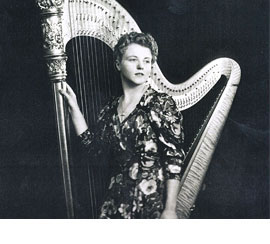 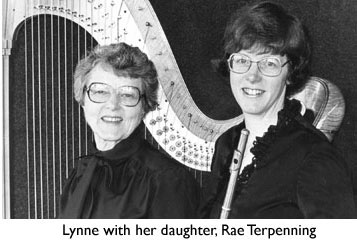
|
|
Lynne Wainwright Palmer—harpist, composer, arranger, teacher, and strong advocate of the American Harp Society--was born Betty Evelyn Wainwright, on December 6, 1918, in Cleveland, Ohio, to highly musical parents. Her mother, Jeannette Wainwright, was a violinist, violist, and pianist, who had attended Oberlin College. Her father, John William (Jack) Wainwright, established the first high school music program in Ohio, and in 1926 established the first summer music camp in the United States in LaGrange, Indiana. In such a home environment, Betty’s musical talent and capability was not treated as extraordinary.
She began studying piano at age three, and added the violin beginning at age six. When she began attending her father’s summer camp at age ten, she played many more instruments, including flute, clarinet, cello, and oboe, depending on what was needed for a particular rehearsal or performance.
Growing up in rural Indiana did not restrict Betty’s early musical experiences. Her mother and a pianist provided accompaniment for silent films at the local theater, and going to Friday movie nights exposed Betty to a wealth of repertoire. She learned to play much of it by ear. And though she enjoyed all the instruments she played, especially the violin, she said that once she began playing the harp, that eclipsed all the others.
Clarence Byrn, of Cass Technical High School in Detroit, first suggested that Betty play the harp. In spite of her father’s initial resistance, Betty went to Detroit for two weeks to study with Velma Froude at Cass. She returned home able to play some arpeggios and three little pieces, and became an instant celebrity. And because three girls in LaGrange wanted to learn to play the harp as soon as they heard her, Betty began to teach almost immediately.
In 1934, Betty’s mother heard a radio broadcast of a student harpist from the Curtis Institute, and recognized that the playing was unusually good. The family decided that Betty should apply to attend and study there, which she did. Betty was accepted at Curtis, but because she was only 16, and because there were only two openings for the three qualified harpists who had auditioned, she was asked to wait a year before attending. That summer, Dr. H.W. Stopher, Director of the School of Music at Louisiana State University, came to her father’s summer music camp to recruit students. As Betty at that point had no firm plans for college, she eagerly accepted his offer, not to enroll as a student, but to teach at LSU in the fall.
Of course, while there she took advantage of many opportunities. She played in the University Symphony and the Opera orchestra. She was a featured soloist with the University Cadet Band, and also with the Shreveport Symphony. She was invited to join an international music honorary fraternity for women, Sigma Alpha Iota, in addition to a scholarship honorary, Alpha Lambda Delta.
The following year she abandoned all the heady acclaim and became a student of Carlos Salzedo at the Curtis Institute of Music in Philadelphia. After some initial discomfort and feelings of intimidation, she began to trust Mr. Salzedo, and worked diligently at learning his technique and applying it with the harp. She eventually became one of his prize students, even changing her name at his suggestion that “Betty” was not an appropriate name for a concert artist, and “Lynne” would be much more suitable.
As her studies with him became more enjoyable, respect and friendship blossomed. She prized a portrait of Mr. Salzedo that he had inscribed, “To Lynne, whose friendship and unique artistry are among the most precious thoughts of my life.”
Lynne’s Curtis career offered a wealth of opportunities. She was one of the original members of the Barton Harp Quintet, organized by Maryjane Mayhew Barton. She played with the Curtis Symphony Orchestra under Fritz Reiner, and the Philadelphia Opera Company under Sylvan Levin. An unexpected vacancy in the Philadelphia Orchestra afforded her an opportunity to play in Carnegie Hall, under Eugene Ormandy. She gave a debut recital at the Barbizon Plaza Concert Hall in New York. Her four years at Curtis culminated in her receiving the first Mary Louise Curtis Bok Award, recognizing her as the outstanding graduate of her class, which also included a gifted young pianist named Leonard Bernstein.
Lynne embarked on a concert and orchestral career, beginning by auditioning and being chosen for Leopold Stokowski’s All-American Youth Orchestra, with which she toured South America in the summer of 1940, and the United States in the summer of 1941. Her next orchestral position was as harpist for the Indianapolis Symphony, under Fabien Sevitsky. The following year she was appointed (without audition) first harpist with the Philadelphia Orchestra. She resigned from that position to marry Alan Palmer and start a family. They lived first in Ann Arbor, Michigan, where Alan was finishing his studies at the University of Michigan Medical School. Lynne began teaching at the university, establishing a harp department that had grown to 22 students by the time she and Alan moved to Seattle in 1947.
In Seattle, Lynne began teaching privately in 1953, and established the harp department at the University of Washington in 1958. Her first private student was Pamela Campbell, later Pamela Vokolek, who succeeded Lynne at the University of Washington. When Ms. Vokolek retired, she was succeeded by another of Lynne’s students, Heidi Lehwalder. Sought out as a teacher and coach throughout her career, Mrs. Palmer inspired students and “grand students” through many years, both from her University of Washington studio and her studio at home.
After she learned of the death of Carlos Salzedo in 1961, Lynne dedicated a significant portion of her time and energy to composition for the harp, studying with Gerald Kechley at the University of Washington. When she was the opening concert artist for the 1984 American Harp Society Conference in St. Paul, Minnesota, the program consisted entirely of her own compositions.
Mrs. Palmer continued composing for most of the rest of her life, in addition to transcribing and arranging works from the classical repertoire, and adding some jazz standards for a change of pace. She has written pieces for students who had special performing opportunities, composed on commission from local orchestras, and in general expanded the harp repertoire. Her works have entered the harp literature, are now being played by some of our finest harpists, and are being selected as required pieces in major competitions.
Lynne recognized early on the need for harpists to have professional connections and to support each other dealing with the unusual demands and opportunities provided by their instrument. Six years after the founding of the American Harp Society, she helped establish the Greater Seattle Chapter of AHS, and served as its first president in 1968–1970. Often serving as adjudicator herself, she influenced the chapter’s dedication to the Music Education Auditions, which have been held every year since the founding of the chapter. She served the AHS in larger capacities, as part of the Board of Directors in 1971–1974, Northwest Regional Director, Chairman of the Board (1989), and Vice President (1989–1990). She organized the National Conference that was held at the University of Washington in 1974.
Lynne Wainwright Palmer was a true pioneer of the harp, and her life and accomplishments stand as an inspiration to hundreds of lives. Those lives, and her music, are her enduring, living legacy.
|
Sally Maxwell
2010
|
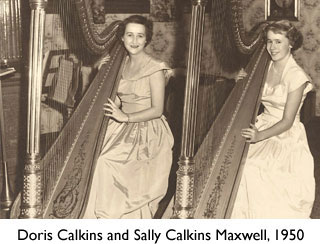 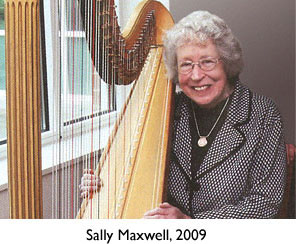
|
|
Coming from a family of musicians, it was natural that Sally Maxwell, harpist and teacher, became a member of the American Harp Society from its beginning. Her mother, Doris Helen Calkins was an outstanding harpist who started the first harp class at the University of Oregon in 1935.
Sally Maxwell began studies of the harp under her mother. As a child, she particularly loved playing her small Clark Irish harp as a young member of the university harp ensemble. As she grew, she played harp at her school and often played as a duo with her mother at churches and musical events.
She later studied with Mildred Dilling, Marcel Grandjany and as a student, she spent a year in Paris, France where she was able to study with the famous harpist and teacher, Henriette Renié. As a student of the University of Oregon in her Junior Year, she returned to Oregon.
After marriage, she taught students in Portland, OR and played with the Portland Opera as well as playing for Broadway Musicals orchestras, etc. With her family, she spent two years in the San Diego area, playing in local orchestras, musicals and concerts while her husband Winston Maxwell was assigned as a doctor during the Vietnam War.
Sally returned to Eugene where she began a twenty year teaching career at the University of Oregon while continuing her performing career at the Eugene Symphony and orchestras throughout Oregon. She assumed leadership roles in the American Harp Society from its earliest days, serving as Northwest Regional Director, as a member of the AHS Board of Directors, on the Board of Readers for the AH Journal, and Chairman of the Harp Literature committee. She also served as Vice President of the AHS prior to serving as President from 1986-1988 and again from 1994-1998.
As many people know, her mother Doris Calkins made it possible for the “Ruth Lorraine Close Awards” to be given to three young harpists annually/nationally through the American Harp Society and the University of Oregon. Sally organized this competition each year. When those awards were no longer possible, she worked with Burton Adams to create and continue the “Anne Adams Awards”.
Sally currently serves as President of the AHS Foundation, a separate non-profit organization whose sole purpose is to support the educational activities of the AHS. The Foundation manages donations from harp-loving benefactors who may invest in specific programs or scholarship awards guaranteeing the continuance of such programs in perpetuity.
Continuing the family tradition, both of Sally’s children are musicians. In addition to their “day jobs” as Physician Assistant and Attorney, Sally’s children Martha and Winston (Jamie) continue to perform regularly as harpist and violinist.
|
Patricia Wooster
2009
|
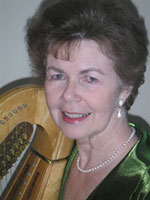 |
|
Since she attended her first AHS National Conference in Seattle in 1974, Pat has missed only one AHS National Conference since she attended her first AHS National Conference in Seattle in 1974. That year she assisted her beloved teacher, Lynne Wainwright Palmer, who chaired the Conference. That exposure to gifted and renowned, but outgoing and helpful harpists was enough to “hook” Pat.
Her service to the AHS began in her local Greater Seattle Chapter and then progressed through regional and national offices until she was elected President of the national organization in 1984. During her 5-year term, Pat initiated the AHS Endowment and helped build the membership to more than 3,000. She held a competition to redesign the AHS’ logo, resulting in the logo still in use. Also during her term, the harp was accepted by ASTA as a string category, and included in ASTA’s national competitions. Pat made presentations to ASTA and MENC conferences regarding the harp.
Pat’s service to the American Harp Society includes being a member or chairman of several national level committees, including Rules, Presidential Advisory, Executive, Nominating, By-Laws Revision, Salzedo Centennial, WHC Liaison, ASTA Liaison, and the ad hoc Strategic Planning Committee. She served as Co-Chair (with Molly Hahn) of AHS’ 28th National Conference held in Washington, DC in 1991. Pat is Chairman of AHS’ 39th National Conference, to be held in Tacoma, Washington, in late June and early July of 2010. She has performed at several National Conferences and has also presented workshops. Pat especially treasures the experience of performing an evening duo harp program with her daughter, Elizabeth, at the National Conference held in June, 2002, in St. Paul, Minnesota.
Pat also has served in several leadership roles in the World Harp Congress, Inc. She was elected to WHC’s Board in 1990 and was elected as Secretary in 1993. In 1996 Pat was Chairman of the highly successful Sixth World Harp Congress, held in Tacoma. She was elected Chairman of the Board of the WHC, Inc. in 1997, replacing Ann Stockton, who had held that post since the founding of the organization. Pat continues as WHC Chairman today.
Pat’s professional career includes holding positions as principal harp and soloist with symphony, chamber, ballet, and opera orchestras, and bands on both the east and west coasts. She has especially enjoyed participating in harp duo and harp and flute work. Perhaps her greatest professional contribution, however, is as a teacher, with students ranging in age from 7 to senior citizens. Pat is harp instructor at Pacific Lutheran University and The University of Puget Sound (both in Tacoma) and maintains a large private studio as well. She founded and still directs the harp training program for the Tacoma Youth Symphony, and conducts a large student harp ensemble organized through the Community Music Program of The University of Puget Sound. Concerts presented by both the ensemble have a dedicated following across the region. Pat also routinely serves as a judge in regional and state music competitions, and in AHS National Competitions.
|
Samuel Milligan
2008
|
 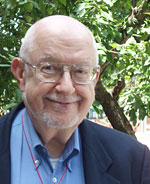 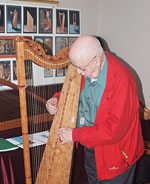
|
|
Samuel Milligan is probably best known for the educational materials he has published for lever harp, but up until retirement in 2000, he also worked as a harp technician, mainly in the Metropolitan New York City area, for 43 years.
Describing himself as a "harp addict," being totally in love with the instrument in all its forms, and anxious to infect everyone else with the same infatuation, he insists "no home should be without one."
Since retirement, Milligan finds time for harp related activities, the latest being to increase interest among harpists in the wide use of the harp in Renaissance and Baroque Spain and the Spanish New World. He also serves as harpist for a local Brooklyn opera company. In between all that, Milligan makes arrangements for the Brooklyn Tutti Harps ensemble and the annual South Texas Harp Ensemble concerts in Corpus Christi.
Sam Milligan has been a member of AHS since the beginning, and has been, in fact, a member of the New York Chapter from the time it was founded by Marcel Grandjany. He was the first editor of the American Harp Journal, and still contributes articles, the most recent being in the Summer 2009 issue, about the harp in Colonial Spanish Texas. In addition, Milligan is the American Harp Society liaison to the Historical Harp Society, in which he is also active.
photo credits: first photo by Van Williams (1961), third photo by William Grant
|
Ruth Wickersham
Papalia
2008
|
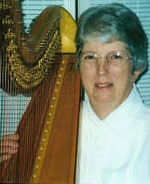 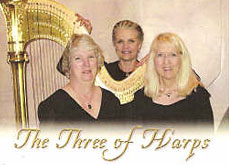
|
|
Ruth Wickersham Papalia was introduced to the harp by Mildred Biehn Johnson, in Quakertown, PA, at the age of nine. By the time she was in high school, Ruth was studying with Edna Phillips, First Harpist of the Philadelphia Orchestra. She entered Oberlin Conservatory of Music, in Ohio, majoring in harp performance under Lucy Lewis. During her college years she studied with Carlos Salzedo at the Summer Harp Colony of America in Camden, Maine. Ruth was accepted at Curtis Institute of Music upon graduation from Oberlin, but chose instead to join the Angelaires Harp Quintet, managed by Columbia Artists. She toured the US and Canada with this group for their two final seasons. Ruth has been soloist with various orchestras and retired from the Cortland, NY, College Community Orchestra after 41 years. In 2004, Ruth, Lucy Scandrett and Jan Bishop formed a trio named The Three of Harps which commissioned two pieces from the British composer Simon Proctor. The Three of Harps has performed over 20 concerts together.
Ruth has been active in the American Harp Society at the national level since 1979. Previous to that she was a co-founder and officer of the Central New York Chapter. Ruth was appointed to fill a vacancy as a Regional Director on the Board of Directors, and was later named to the Executive Committee. She has served as AHS Secretary, AHS Treasurer and Chairman of the Board of Directors. She was on the founding committee of the AHS Foundation and served as its first Treasurer. Ruth was responsible for writing a grant to fund the former Young Artist Program of the AHS. As Rules Committee Chairman, she led the revision of the AHS Bylaws in 1998. She has served on the American Harp Journal Board of Readers and as a judge for the AHS Competition. Ruth and her husband, Dr. Anthony Papalia, a psychologist have written articles and presented workshops at National Conferences on topics such as Dealing with Performance Tension and Teaching Styles. Ruth acknowledges the fine people who have served as her mentors and is a firm believer the AHS is a true ensemble of people sharing ideas, pursuing common goals and promoting the harp.
|
Anne & Burton Adams
2007
|
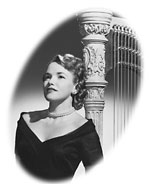 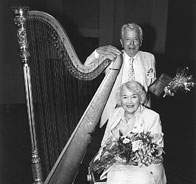
|
|
Anne Adams was introduced to the harp by New York harpist Anna Louis David at age 9, after having already studied piano, harmony, ear-training and solfege with her mother, concert pianist Phyllida Ashley. Upon graduating from high school, Anne went to New York, where Salzedo invited her to study at Curtis after hearing her perform. Instead, at her parents’ request, she attended colleges in California, studying with Marietta Bitter, who trained her in the Salzedo technique. Convinced by her family to attend Marcel Grandjany’s Master Class at nearby Mills College, Anne soon accepted his invitation to join his first class at Juilliard, where she studied for three and a half years. When Grandjany became ill, Anne premiered his Aria in Classic Style for harp and organ.
Anne had briefly met her future husband the day before she left for New York, but it was during a visit home for Christmas years later that they became inseparable. Dr. Adams arranged to be appointed to Bellevue Hospital to be near her when she went back to New York. Soon Anne returned to California to audition for the second harp position in the San Francisco Symphony. Within a month of Anne’s winning the audition, Burton Adams was “called up” at the start of World War II and ordered to report to California. They were married before he headed overseas.
Between San Francisco Symphony obligations, Anne played on the radio for The Light and Mellow Beer Show and the Standard School Radio Broadcasts with Carman Dragon, moving with him to television, also performing with the Little Symphony Orchestra of San Francisco on weekly television concerts. When Virginia Morgan retired from the San Francisco Symphony in 1951, Anne auditioned for and won the principal harp position. In 1952, after Kajetan Attl, principal harp for the San Francisco Opera, was in a car accident, Anne took over for him as well. Performing with the Symphony, Opera, visiting ballets, and Summer Pops, she played under the baton of every major conductor in the world.
Anne has also performed, recorded and toured as a soloist and with chamber groups, including the Lyra ensemble. A highly regarded teacher, she maintained a private studio and served on the faculty of Mills College in Oakland, and later the College of Holy Names. Treasuring her husband and four daughters, Anne worked to create a gracious home for them despite her strenuous schedule.
Always generous, gracious, and supportive of other harpists, Anne served three terms on the Board of Directors of the AHS and acted for a number of years as custodian of the AHS Tape Library. At National Conferences, she served on panels, often performed on chamber music concerts, and encouraged her students who participated in the AHS National Competitions. From 1990 to 2003, as a tribute to his wife, Dr. Burton Adams funded the Anne Adams Awards with his generous donations. These scholarships have helped many, many harp students continue their studies.
|
Ann Mason Stockton
2006
|
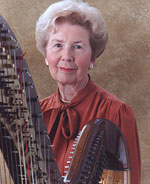
|
| |
|
|
b. October 30, 1916
d. August 11, 2006
Ann Mason Stockton is most known by many as the Hollywood harpist, having played for over 800 film scores, including Gone with the Wind and Schindler’s List, in which she even had a cameo. However, in the harp world, Ann Mason Stockton is known for her great leadership: for the number of years she served the American Harp Society, and for being a Chairman and founding member of the World Harp Congress.
Ann took interest in the harp when she was about 3 or 4. She started both piano and harp, but piano was quickly dropped. When she was 7 she received her first pedal harp and at 9 started harp lessons with Alfred Kastner. She attended the National Music Camp at Interlochen, MI, San Mateo Junior College, and received a Bachelor of Education Degree from UCLA. She played with the Los Angeles Philharmonic before going into commercial music.
Ann Mason Stockton was pivotal in starting the AHS chapter in Los Angeles, and her leadership skills did not go unrecognized. In 1968 she was invited to serve as a National Chairman for AHS, which lead to 12 years of service from 1968 to 1980. For six years she sat on the Board of Directors, serving the last four as President of the AHS. Many new committees were established while she was president, including: Advisory, Fund Raising, Grandjany Memorial Fund, Research Projects, and School and Faculties for Harp Study. She performed at Conferences in 1966, 1970, and 1974. When interviewed by Jane Weidensaul for the American Harp Journal in 1982, Ms. Stockton said, “Becoming involved with the AHS was another turning point in my life.” To say that Ann Mason Stockton was involved in the American Harp Society is an understatement.
|
Dorothy Remsen
2004
|
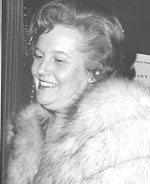 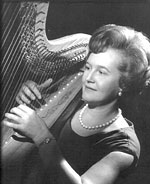
|
|
Dorothy Remsen’s service to the harp and the American Harp Society, Inc. spans more than three decades and encompasses many different jobs including those of Los Angeles Chapter President, Western Regional Director, six years as National Secretary, 27 years as Executive Secretary, serving as the National Competitions Chairman in 1966, and as the National Competitions Office Assistant since 1996.
Dorothy began the study of the harp with Mildred Godfrey Hall, and later attended the Eastman School of Music where she studied with Eileen Malone. She has served as Principal Harpist with the National Symphony Orchestra, Buffalo Philharmonic Orchestra, Minneapolis Symphony Orchestra, Glendale Symphony Orchestra, Los Angeles Chamber Orchestra, and Los Angeles Opera; and as second harpist with the Los Angeles Philharmonic Orchestra and the Hollywood Bowl Orchestra.
In her ‘spare’ time, Dorothy spent 41 years as a freelance harpist for all of the major and independent motion picture studios, and for 20 years was a frequent performer for the Monday Evening Concerts, a series of 20th century music presented at the Los Angeles County Museum. Dorothy lists her many prizes and awards as the “many opportunities I had to work with some of the finest musicians on the planet.”
|
Catherine Gotthoffer
2002
|
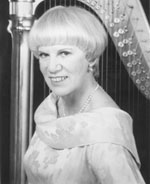 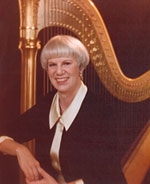
|
| |
|
|
Catherine Gotthoffer began her musical studies at a young age on the violin and started harp at a later age. After high school, she continued her studies on harp at Julliard with Marcel Grandjany. Ms. Gotthoffer was able to extend her studies from three years to five years due to a busy working schedule. While at school, she met her husband, a student of trumpet, Robert Gotthoffer, and they wed in 1944. After graduation from Julliard, she maintained a busy schedule by freelancing in New York City, performing regularly in New York City's Latin Quarter and Biltmore Hotel while her husband was in the Navy.
After the war ended and Mr. Gotthoffer was discharged from the Navy, he learned that Antal Dorati was organizing a symphony in Dallas. Both Mr. and Mrs. Gotthoffer auditioned, were accepted, and relocated to Dallas, where they lived for seven years, with their summers spent in New York City.
In 1951, Ms. Gotthoffer auditioned for the MGM studios and received a contract with MGM starting in January of 1952 and continuing through 1957. During this time, her two children, Ann and Richard, were born. Ms. Gotthoffer continued playing and recording with many symphony orchestras after her contract with MGM. In 1970 she joined the faculty at the California Institute of the Arts. Her last “gig” was in 1988 at a Tony Bennett concert. Films credits include: Singing the Rain; An American in Paris; West Side Story; Gigi; Kiss Me Kate; High Society; Dr. Zhivago; The Godfather and Godfather II; Bad Day at Blackrock; My Fair Lady; Barefoot in the Park; and Beetlejuice.
Ms. Gotthoffer’s involvement in the American Society started after the first Israel Competition in 1959. She helped found the local chapter in Los Angeles, which was the second local chapter to seek a charter from the AHS. From 1968-1970, Ms. Gotthoffer was President of the AHS. During her tenure, the AHS Constitution was changed to include direct election of all officers and an annual Treasurer’s Report to the members. From 1972 – 1976, she once again served as AHS President. Ms. Gotthoffer became the first life member of the AHS, which grew and flourished under her direction.
|



